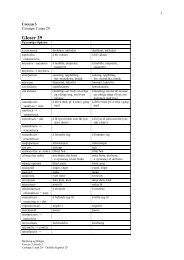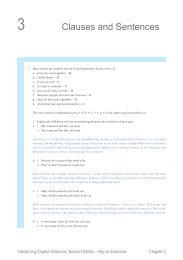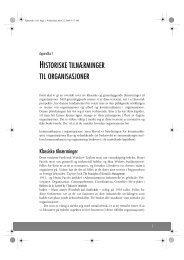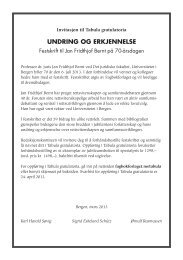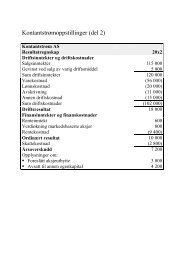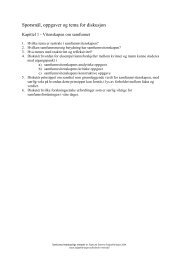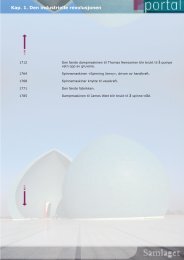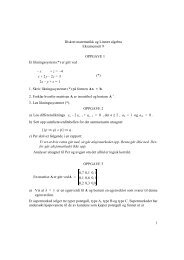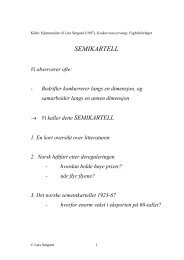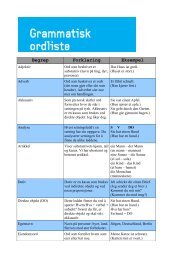price discrimination in the airline industry - Fagbokforlaget
price discrimination in the airline industry - Fagbokforlaget
price discrimination in the airline industry - Fagbokforlaget
Create successful ePaper yourself
Turn your PDF publications into a flip-book with our unique Google optimized e-Paper software.
PRICE DISCRIMINATIONINTHE AIRLINE INDUSTRYFrode Steen and Lars SørgardDepartment of EconomicsNorwegian School of Economics and Bus<strong>in</strong>ess Adm<strong>in</strong>istrationHelleveien 30, 5045 BergenNORWAYEmails: frode.steen@nhh.no and lars.sorgard@nhh.noAbstract:The purpose of this report is to discuss <strong>the</strong> welfare effects of different k<strong>in</strong>ds of <strong>price</strong><strong>discrim<strong>in</strong>ation</strong> schedules that are used <strong>in</strong> <strong>the</strong> airl<strong>in</strong>e <strong>in</strong>dustry. We dist<strong>in</strong>guish betweenversion<strong>in</strong>g, discount to large consumers, and frequent flyer programs. It is argued thatversion<strong>in</strong>g is probably welfare improv<strong>in</strong>g, especially <strong>in</strong> a competitive sett<strong>in</strong>g.Fur<strong>the</strong>rmore, it is argued that discounts to large firm has an ambiguous effect on welfare<strong>in</strong> monopoly, while it is likely that it is detrimental to welfare <strong>in</strong> a competitive sett<strong>in</strong>g or<strong>in</strong> a sett<strong>in</strong>g with a dom<strong>in</strong>ant carrier threatened by entry. F<strong>in</strong>ally, we argue that frequentflyer programs have anticompetitive effects <strong>in</strong> an oligopoly, and especially <strong>in</strong> a sett<strong>in</strong>gwhere an established is threatened by entry, so that such programs are expected to bedetrimental to welfare.Report submitted to <strong>the</strong> committee analyz<strong>in</strong>g <strong>the</strong> airl<strong>in</strong>e <strong>in</strong>dustry <strong>in</strong> <strong>the</strong> Nordic countries,with members from <strong>the</strong> Competition Authorities <strong>in</strong> Denmark, F<strong>in</strong>land, Norway andSweden© Steen and Sørgard 1
1. INTRODUCTIONPrice <strong>discrim<strong>in</strong>ation</strong> is observed <strong>in</strong> most <strong>in</strong>dustries. It implies that firms are charg<strong>in</strong>gdifferent <strong>price</strong>s from different consumers, and that <strong>the</strong> <strong>price</strong> difference cannot beexpla<strong>in</strong>ed by cost differences. It is well known that <strong>the</strong> airl<strong>in</strong>e <strong>in</strong>dustry has practiced <strong>price</strong><strong>discrim<strong>in</strong>ation</strong> for many years. We all know that on each flight <strong>the</strong> passengers have paiddifferent <strong>price</strong>s, and that <strong>in</strong> some cases we can observe that <strong>the</strong> highest <strong>price</strong> is as muchas five times <strong>the</strong> lowest <strong>price</strong>.Is <strong>price</strong> <strong>discrim<strong>in</strong>ation</strong> a good or bad th<strong>in</strong>g for <strong>the</strong> airl<strong>in</strong>e passengers and <strong>the</strong>society? To answer such a question, we must focus on <strong>the</strong> <strong>price</strong> <strong>discrim<strong>in</strong>ation</strong> that ismost common <strong>in</strong> this particular <strong>in</strong>dustry.A casual observation would be that <strong>the</strong>re are numerous different versions of anairl<strong>in</strong>e ticket to choose among. You can buy an expensive, flexible ticket. Then you areallowed to reschedule <strong>the</strong> flight or even cancel it without any costs. Or you can buy acheap ticket, with many restrictions. For example, a Saturday night stay-over is requiredand so is advance-purchase. S<strong>in</strong>ce each and every passenger can choose betweendifferent versions of an air ticket, it is natural to consider <strong>the</strong> <strong>the</strong>ory of version<strong>in</strong>g whenanalyz<strong>in</strong>g <strong>the</strong> <strong>price</strong> <strong>discrim<strong>in</strong>ation</strong> <strong>in</strong> this particular <strong>in</strong>dustry.Ano<strong>the</strong>r common characteristics <strong>in</strong> many national markets is that large firms thatdemands airl<strong>in</strong>e tickets write a contract with an airl<strong>in</strong>e, where <strong>the</strong> firms’ employeesreceives a certa<strong>in</strong> discount on each airl<strong>in</strong>e ticket. This k<strong>in</strong>d of <strong>price</strong> <strong>discrim<strong>in</strong>ation</strong>, wheredifferent groups are charged different <strong>price</strong>s, is <strong>the</strong>refore also a type of <strong>price</strong><strong>discrim<strong>in</strong>ation</strong> that we will analyse and discuss <strong>the</strong> effect of for <strong>the</strong> <strong>in</strong>dustry <strong>in</strong> question.F<strong>in</strong>ally, frequent flyers programs are important <strong>in</strong> <strong>the</strong> airl<strong>in</strong>e <strong>in</strong>dustry. It impliesthat those who are members of such a program can earn member po<strong>in</strong>ts for each flightand later use <strong>the</strong> po<strong>in</strong>ts to claim a free bonus flight. It can be seen as a k<strong>in</strong>d of discount,and <strong>in</strong> that respect it is a k<strong>in</strong>d of <strong>price</strong> <strong>discrim<strong>in</strong>ation</strong>. Therefore, we will also consider <strong>the</strong>welfare effects of frequent flyer programs.Based on <strong>the</strong> characteristics of this <strong>in</strong>dustry, we have chosen to discuss threedifferent k<strong>in</strong>ds of <strong>price</strong> <strong>discrim<strong>in</strong>ation</strong>: (i) version<strong>in</strong>g, (ii) discounts to large consumers,and (iii) frequent flyer programs. In Section 2 we present a <strong>the</strong>oretical analysis of <strong>the</strong>© Steen and Sørgard 2
various k<strong>in</strong>ds of <strong>price</strong> <strong>discrim<strong>in</strong>ation</strong>. In Section 3 we relate <strong>the</strong> results from <strong>the</strong><strong>the</strong>oretical discussion to <strong>the</strong> airl<strong>in</strong>e <strong>in</strong>dustry. Our f<strong>in</strong>d<strong>in</strong>gs are summarized <strong>in</strong> Section 4.2. THEORY OF PRICE DISCRIMINATIONAs illustrated <strong>in</strong> <strong>the</strong> <strong>in</strong>troduction, <strong>price</strong> <strong>discrim<strong>in</strong>ation</strong> can take various forms. In <strong>the</strong>literature it is common to dist<strong>in</strong>guish between three different k<strong>in</strong>ds of <strong>price</strong><strong>discrim<strong>in</strong>ation</strong>. Accord<strong>in</strong>g to Varian (1989), we have <strong>the</strong> follow<strong>in</strong>g def<strong>in</strong>itions:• First degree: The seller charges a different <strong>price</strong> for each unit, so that <strong>the</strong> <strong>price</strong> ofeach unit equals maximum will<strong>in</strong>gness to pay.• Second degree: Each consumer faces <strong>the</strong> same <strong>price</strong> schedule, but <strong>the</strong> schedule<strong>in</strong>volves different <strong>price</strong>s for different amounts of <strong>the</strong> good purchased.• Third degree: Different consumers are charged different <strong>price</strong>s, but eachconsumer pays a constant <strong>price</strong> for each unit of <strong>the</strong> good bought.How does <strong>the</strong> three forms of <strong>price</strong> <strong>discrim<strong>in</strong>ation</strong> we described – version<strong>in</strong>g, discount tolarge consumers, and frequent flyer programs – fit <strong>in</strong>to this def<strong>in</strong>ition? Version<strong>in</strong>gimplies that all consumers are fac<strong>in</strong>g <strong>the</strong> same <strong>price</strong> schedule. They can choose to buy anexpensive, high quality version or a cheap, low quality version. Technically, this is anexample of second degree <strong>price</strong> <strong>discrim<strong>in</strong>ation</strong>. The consumers pay different <strong>price</strong>s fordifferent amount of quality of <strong>the</strong> good purchased. Discounts to large consumers isobviously an example of third degree <strong>price</strong> <strong>discrim<strong>in</strong>ation</strong>. F<strong>in</strong>ally, a frequent flyerprogram is an example of second degree <strong>price</strong> <strong>discrim<strong>in</strong>ation</strong>. The consumers arerewarded for large purchases, and <strong>the</strong>y receive a special k<strong>in</strong>d of quantity discount.The <strong>the</strong>ory of <strong>price</strong> <strong>discrim<strong>in</strong>ation</strong> is primarily concerned with a situation with amonopoly firm. Let us <strong>the</strong>refore start out by expla<strong>in</strong><strong>in</strong>g <strong>the</strong> <strong>the</strong>ory of version<strong>in</strong>g <strong>in</strong> amonopoly sett<strong>in</strong>g (section 2.1) and <strong>the</strong>n discuss <strong>the</strong> welfare effect of version<strong>in</strong>g <strong>in</strong> such asett<strong>in</strong>g (section 2.2). 1 Then we discuss how <strong>the</strong> conclusion drawn <strong>in</strong> a monopoly modelmay change when we have an oligopolistic market (section 2.3). F<strong>in</strong>ally, we relate ourdiscussion to two more special arrangements <strong>in</strong> <strong>the</strong> airl<strong>in</strong>e <strong>in</strong>dustry: selective discounts tolarge consumers (section 2.4) and frequent flyer programs (section 2.5). In both those1 The notion ‘version<strong>in</strong>g’ was <strong>in</strong>troduced <strong>in</strong> Shapiro and Varian (1998).© Steen and Sørgard 3
cases we start out by discuss<strong>in</strong>g monopoly, and <strong>the</strong>n we extend <strong>the</strong> analysis to anoligopolistic sett<strong>in</strong>g.2.1 The motives for version<strong>in</strong>g 2Let us for <strong>the</strong> moment consider a situation with only one firm. To simplify fur<strong>the</strong>r, weassume that <strong>the</strong>re are only two consumers. Each of <strong>the</strong>m demands one unit. Thewill<strong>in</strong>gness to pay for each of <strong>the</strong>m for this unit depends on <strong>the</strong> quality of <strong>the</strong> good. Torelate <strong>the</strong> sett<strong>in</strong>g to <strong>the</strong> airl<strong>in</strong>e <strong>in</strong>dustry, we may denote consumer 1 a bus<strong>in</strong>ess passengerand consumer 2 a leisure passenger. In Figure 1 we have illustrated <strong>the</strong> marg<strong>in</strong>alwill<strong>in</strong>gness to pay for each of <strong>the</strong> consumers for different levels of <strong>the</strong> quality of <strong>the</strong>good.Figure 1Quality versus marg<strong>in</strong>al will<strong>in</strong>gness to payMarg<strong>in</strong>alwill<strong>in</strong>gness topayBConsumer 1 demandConsumer 2 demandAQ 2CQ 1QualityThe area below <strong>the</strong> marg<strong>in</strong>al-will<strong>in</strong>gness-to-pay curve denotes <strong>the</strong> total will<strong>in</strong>gness topay. If quality is Q 1 (or higher), <strong>the</strong>n consumer 1 is will<strong>in</strong>g to pay A+B+C for <strong>the</strong> good.2 The model we present here draws heavily on Varian (2000). For o<strong>the</strong>r models of version<strong>in</strong>g, seeDeneckere and McAfee (1996) and Foros, Jensen and Sand (2001).© Steen and Sørgard 4
If <strong>the</strong> quality of <strong>the</strong> good equals Q 2 , <strong>the</strong>n consumer 1 is will<strong>in</strong>g to pay A+B whileconsumer 2 is will<strong>in</strong>g to pay A.We assume that it is not more costly to produce a high quality than a low qualityproduct. As we will expla<strong>in</strong> later, typically <strong>the</strong> low quality version is a damaged versionof <strong>the</strong> high quality version (called damag<strong>in</strong>g product). If so, it is not obvious that <strong>the</strong> highquality version is <strong>the</strong> most costly one to produce.If we assume that <strong>the</strong>re are no costs associated with produc<strong>in</strong>g a high quality<strong>in</strong>stead of a low quality version, what <strong>the</strong>n would <strong>the</strong> firm do? It would <strong>the</strong>n produce aversion with high quality, which <strong>in</strong> Figure 1 is quality Q 1 , and sell it at a <strong>price</strong> of A toconsumer 2 and A+B+C to consumer 1. Then <strong>the</strong> firm would extract all potentialconsumer surplus, and it would earn 2A+B+C.But it is obvious that this is unrealistic. If <strong>the</strong> consumers can choose, <strong>the</strong>n bothconsumers would of course buy <strong>the</strong> low <strong>price</strong> version. Then <strong>the</strong> firm would earn only 2A.As argued, <strong>the</strong> consumer supposed to buy <strong>the</strong> high <strong>price</strong> product buys <strong>the</strong> low<strong>price</strong> product. The low <strong>price</strong> product cannibalizes <strong>the</strong> earn<strong>in</strong>gs from <strong>the</strong> most valuablemarket segment. How could <strong>the</strong> firm avoid such a cannibalization? One possible solutionis, as <strong>in</strong>dicated above, product damag<strong>in</strong>g. Let us assume that <strong>the</strong> high quality version(quality Q 1 ) is still produced. Fur<strong>the</strong>rmore, let us assume that <strong>the</strong> quality of <strong>the</strong> secondversion equals Q 2 , and thus can be considered as a damaged product. This implies thatconsumer 2 still has a will<strong>in</strong>gness to pay equal to A for <strong>the</strong> damaged version. Consumer1, on <strong>the</strong> o<strong>the</strong>r hand, has a higher will<strong>in</strong>gness to pay for quality. He is will<strong>in</strong>g to pay A+Bfor <strong>the</strong> damaged version.What if <strong>the</strong> firm now sets <strong>price</strong> A on <strong>the</strong> damaged good? Then it extracts allpotential consumer surplus from consumer 2. If so, which <strong>price</strong> should it set on <strong>the</strong> highquality version? Consumer 1 has a high will<strong>in</strong>gness to pay, so <strong>the</strong> firm would prefer tha<strong>the</strong> buys <strong>the</strong> high quality version. But what is <strong>the</strong> maximum <strong>price</strong> <strong>the</strong> firm can charge on<strong>the</strong> high quality version? If consumer 1 buys <strong>the</strong> damaged product, it pays A and receivesa consumer surplus equal to B. Then <strong>the</strong> firm must set a <strong>price</strong> on <strong>the</strong> high quality productso that consumer 1 receives at least B <strong>in</strong> consumer surplus. We see from Figure 1 that <strong>the</strong>firm can charge (slightly less than) A+C for <strong>the</strong> high quality product, and consumer 1 will© Steen and Sørgard 5
<strong>the</strong>n choose <strong>the</strong> ‘right’ version. If so, <strong>the</strong> firm earns 2A + C. By damag<strong>in</strong>g one version of<strong>the</strong> product <strong>the</strong> firm has <strong>in</strong>creased its earn<strong>in</strong>g with C.Why has such a strategy been profitable for <strong>the</strong> firm? It does not earn more from<strong>the</strong> consumer with a low will<strong>in</strong>gness to pay, despite <strong>the</strong> fact that <strong>the</strong> damaged version isment for that particular consumer. The po<strong>in</strong>t is that <strong>the</strong> consumer with <strong>the</strong> highwill<strong>in</strong>gness to pay has a less attractive alternative. It implies that <strong>the</strong> firm can charge ahigher <strong>price</strong> on <strong>the</strong> high quality version, and still be sure that consumer 1 buys <strong>the</strong> highquality version.However, <strong>the</strong> firm can earn even more. We know that <strong>the</strong> consumer with a hightotal will<strong>in</strong>gness to pay would value a marg<strong>in</strong>al <strong>in</strong>crease <strong>in</strong> quality higher than what is <strong>the</strong>case for <strong>the</strong> consumer with <strong>the</strong> low total will<strong>in</strong>gness to pay for <strong>the</strong> product. This isillustrated <strong>in</strong> Figure 1 with <strong>the</strong> fact that <strong>the</strong> marg<strong>in</strong>al will<strong>in</strong>gness to pay curve forconsumer 1 is to <strong>the</strong> North East of <strong>the</strong> marg<strong>in</strong>al will<strong>in</strong>gness to pay curve for consumer 2.The firm can exploit this by damag<strong>in</strong>g <strong>the</strong> product even fur<strong>the</strong>r. This is illustrated <strong>in</strong>Figure 2.Figure 2 Damag<strong>in</strong>g product no. 2Marg<strong>in</strong>alwill<strong>in</strong>gnessto payB 1Consumer 1 demandConsumer 2 demandA 1Q 2Q 1B 2A 2CQ 3Quality© Steen and Sørgard 6
As shown <strong>in</strong> Figure 3, <strong>the</strong> quality on <strong>the</strong> damaged version equals Q 3 . It implies thatconsumer 2 is will<strong>in</strong>g to pay A 1 for <strong>the</strong> damaged product. If <strong>the</strong> firm decides to offer sucha damaged product, it would lose revenues equal to A 2 from <strong>the</strong> sale to consumer 2. On<strong>the</strong> o<strong>the</strong>r hand, <strong>the</strong> damaged product is now less valuable for consumer 1. The alternativeto <strong>the</strong> high quality version is thus less attractive. The firm can <strong>the</strong>refore <strong>in</strong>crease <strong>the</strong> <strong>price</strong>of <strong>the</strong> high quality version and still be sure that consumer 1 chooses to buy <strong>the</strong> highquality version. It can easily be seen that <strong>the</strong> firm sets <strong>the</strong> <strong>price</strong> (slightly less than) A 1 +A 2 + B 2 + C. Consumer 1 will still choose <strong>the</strong> ‘right’ version.The total revenue for <strong>the</strong> firm is now 2A 1 + A 2 + B 2 + C. Compar<strong>in</strong>g with Figure1, we see that <strong>the</strong> firm is better off if B 2 > A 2 , i.e., <strong>the</strong> <strong>in</strong>crease <strong>in</strong> revenue from consumer1 outweighs <strong>the</strong> loss of revenue from consumer 2. This is true Figure 2. It can <strong>the</strong>n easilybe shown that it will always be profitable for <strong>the</strong> firm to set quality below Q 2 for <strong>the</strong>damaged product. How much product damag<strong>in</strong>g that is profitable will depend on (i) <strong>the</strong>difference <strong>in</strong> will<strong>in</strong>gness to pay for quality for consumer 1 and 2, and (ii) <strong>the</strong> number ofconsumer s<strong>in</strong> each group. The latter effect is not taken <strong>in</strong>to account <strong>in</strong> our model, s<strong>in</strong>cewe assume that <strong>the</strong>re is only one consumer of each type. However, it can easily be shownthat <strong>the</strong> degree of product damag<strong>in</strong>g will <strong>in</strong>crease <strong>in</strong> <strong>the</strong> number of consumers of type 1(<strong>the</strong> consumer with <strong>the</strong> high will<strong>in</strong>gness to pay for quality).The analysis is very stylized, but it illustrates a firm’s <strong>in</strong>centives to damage aproduct. Note that <strong>the</strong> reason for damag<strong>in</strong>g <strong>the</strong> product is not to tailor <strong>the</strong> quality to <strong>the</strong>consumer with a low will<strong>in</strong>gness to pay. The crucial po<strong>in</strong>t is that <strong>the</strong> consumer with highwill<strong>in</strong>gness to pay has a less attractive alternative. The firm would choose to damage <strong>the</strong>product to such a degree than even <strong>the</strong> consumer with <strong>the</strong> low will<strong>in</strong>gness to pay forquality is hurt. In such a perspective <strong>the</strong> product damag<strong>in</strong>g can be regarded as severe.2.2 The welfare effects of version<strong>in</strong>gAs shown <strong>in</strong> <strong>the</strong> previous Section, version<strong>in</strong>g implies that one version of <strong>the</strong> product isdamaged. The consumer with a low will<strong>in</strong>gness to pay is offered an <strong>in</strong>ferior version. Atfirst sight this may seem detrimental to welfare. As we will see, this may not be true. Thecrucial question is: what is <strong>the</strong> alternative to version<strong>in</strong>g?© Steen and Sørgard 7
The alternative to version<strong>in</strong>g is no version<strong>in</strong>g. In our sett<strong>in</strong>g no version<strong>in</strong>g impliesthat one <strong>in</strong>stead of two versions is supplied. S<strong>in</strong>ce <strong>the</strong>re are two different consumers, <strong>the</strong>firm may ei<strong>the</strong>r serve only one of <strong>the</strong>m or serve both.If <strong>the</strong> firm serves only one of <strong>the</strong>m, it is obvious that it would serve consumer 1 –<strong>the</strong> one with <strong>the</strong> highest will<strong>in</strong>gness to pay. Then it would set quality equal to Q 1 and seta <strong>price</strong> equal to A+B+C. The firm would extract all potential consumer surplus and earnA+B+C, which equals total welfare <strong>in</strong> this regime. If we compare with version<strong>in</strong>g, it isobvious that version<strong>in</strong>g would improve welfare. Consumer 1 will still be served, and <strong>the</strong>high quality version generates welfare (consumer surplus plus profits) equal to A+B+C,as is <strong>the</strong> case with no version<strong>in</strong>g. But, <strong>in</strong> addition, <strong>the</strong> consumer with <strong>the</strong> low will<strong>in</strong>gnessto pay buys <strong>the</strong> damaged product at a <strong>price</strong> A 1 . This adds to <strong>the</strong> welfare generated by <strong>the</strong>high quality product, and version<strong>in</strong>g will <strong>the</strong>refore always <strong>in</strong>crease welfare.If <strong>the</strong> firm serves both consumers <strong>in</strong> <strong>the</strong> case with no version<strong>in</strong>g, <strong>the</strong> welfareeffect of version<strong>in</strong>g is more complicated. To illustrate this, let us take <strong>in</strong>to account that<strong>the</strong> number of consumers can differ between segments. So far we have only consideredtwo consumers, consumer 1 and 2. Let us now assume that <strong>the</strong>re are several consumers oftype 1 and several of type 2. In particular, we assume that a fraction γ of <strong>the</strong> consumersare of type 1 (and <strong>the</strong>reby a fraction (1- γ) is of type 2).Which quality would <strong>the</strong> firm choose if it sells only one version and serves bothtypes of consumers? As argued <strong>in</strong> association with Figure 1, <strong>the</strong>re is no additionalrevenue it can earn if it sets quality higher than Q 2 . As long as <strong>the</strong> cost of quality ispositive, even if it is <strong>in</strong>f<strong>in</strong>itesimal small, <strong>the</strong> firm sets quality Q 2 . If so, <strong>the</strong> total surpluswith no version<strong>in</strong>g equals A + γB, where <strong>the</strong> firm earns A and <strong>the</strong> type 1 consumers has aconsumers surplus equal to γB. Then we must compare this total surplus with <strong>the</strong> totalsurplus generated with version<strong>in</strong>g. We have that version<strong>in</strong>g will <strong>in</strong>crease welfare if:(1 – γ)A 1 + γ(A 1 + A 2 + B 2 + C) + γB 1 > A + γBThe first and second expressions on <strong>the</strong> left hand side are <strong>the</strong> profits earned on consumertypes 2 and 1, respectively, while <strong>the</strong> third expression on <strong>the</strong> left hand side is type 1© Steen and Sørgard 8
consumers’ consumer surplus. Rearrang<strong>in</strong>g, we have that version<strong>in</strong>g will <strong>in</strong>crease welfareif:γC > (1 - γ)A 2The left hand side is <strong>the</strong> additional surplus generated by offer<strong>in</strong>g a high quality version(Q 1 <strong>in</strong>stead of Q 2 ), while <strong>the</strong> right hand side is <strong>the</strong> loss of consumer surplus for <strong>the</strong> type 2consumers.From <strong>the</strong> above expression we can see what would be of importance for whe<strong>the</strong>rversion<strong>in</strong>g is welfare improv<strong>in</strong>g or not. There are three factors that may lead to welfareimprov<strong>in</strong>g version<strong>in</strong>g: (i) <strong>the</strong> fraction of <strong>the</strong> consumers with high will<strong>in</strong>gness to pay(consumers of type 1) is large, (ii) <strong>the</strong>ir valuation of extra quality is high, and (iii) <strong>the</strong>o<strong>the</strong>r group’s valuation of quality degradation is limited.Although one could get a rough <strong>in</strong>dication of <strong>the</strong> magnitude of <strong>the</strong>se three factors<strong>in</strong> a particular market, how could one decide whe<strong>the</strong>r version<strong>in</strong>g is welfare improv<strong>in</strong>g ornot? Follow<strong>in</strong>g Varian (1996), we should focus on whe<strong>the</strong>r version<strong>in</strong>g leads to an<strong>in</strong>crease <strong>in</strong> total output. If version<strong>in</strong>g implies that some groups are served that else wouldnot have been served, version<strong>in</strong>g is expected to lead to higher welfare.2.3 Version<strong>in</strong>g and competitionSo far we have only considered a monopoly situation. What if <strong>the</strong>re is more than one firm<strong>in</strong> <strong>the</strong> market? It is difficult to give a general answer to such a question, because itdepends on <strong>the</strong> toughness of <strong>price</strong> competition. In <strong>the</strong> literature is has been shown that<strong>price</strong> <strong>discrim<strong>in</strong>ation</strong> may collapse <strong>in</strong> such a sett<strong>in</strong>g. 3 Each firm has <strong>in</strong>centive to undercut<strong>the</strong> rival’s <strong>price</strong> schedule. If so, this may lead to <strong>price</strong> equal to marg<strong>in</strong>al costs and what islabeled <strong>the</strong> Bertrand paradox <strong>in</strong> <strong>the</strong> literature. It is a paradox, because we seldomexperience that k<strong>in</strong>d of fierce competition on <strong>price</strong>s that <strong>the</strong>ory predicts. Casualobservation <strong>in</strong>dicates that <strong>in</strong> <strong>the</strong> airl<strong>in</strong>e <strong>in</strong>dustry we do not observe <strong>price</strong> equal tomarg<strong>in</strong>al costs. On <strong>the</strong> o<strong>the</strong>r hand, we do observe that each airl<strong>in</strong>e offers differentversions of its air ticket even <strong>in</strong> a sett<strong>in</strong>g where airl<strong>in</strong>es compete. This clearly shows that3 See, for example, Mandy (1992).© Steen and Sørgard 9
<strong>in</strong> <strong>the</strong> airl<strong>in</strong>e <strong>in</strong>dustry version<strong>in</strong>g is of importance also <strong>in</strong> a competitive sett<strong>in</strong>g, so that<strong>price</strong> <strong>discrim<strong>in</strong>ation</strong> is viable <strong>in</strong> this particular <strong>in</strong>dustry even <strong>in</strong> a competitive sett<strong>in</strong>g.To illustrate how competition may affect <strong>the</strong> degree of version<strong>in</strong>g, let us extend<strong>the</strong> sett<strong>in</strong>g we discussed above. Let us assume that competition leads to more availablecapacity. To avoid idle capacity, <strong>the</strong> firms can respond <strong>in</strong> different ways. One way is tolower <strong>price</strong>s. Ano<strong>the</strong>r way would be to extend <strong>the</strong> sale of <strong>the</strong> damaged product. In <strong>the</strong>airl<strong>in</strong>e <strong>in</strong>dustry, <strong>the</strong> latter would imply that <strong>the</strong> firms <strong>in</strong>crease <strong>the</strong> number of restrictedtickets or that each restrictive ticket becomes less restrictive. To illustrate <strong>the</strong> effects ofthis, let us dist<strong>in</strong>guish between <strong>the</strong> bus<strong>in</strong>ess segment and <strong>the</strong> leisure segment. The effectof a shift from monopoly to competition <strong>in</strong> <strong>the</strong> leisure segment is illustrated <strong>in</strong> Figure 3.Figure 3 The effect <strong>in</strong> <strong>the</strong> leisure segment of competitionPriceDemandMONP LDUOP LMONX LDUOX LQuantityIn Figure 3 we have illustrated <strong>the</strong> effect of lower <strong>price</strong>s, see <strong>the</strong> arrow shown on <strong>the</strong>vertical axis. In addition, we have illustrated <strong>the</strong> effect of less severe product damag<strong>in</strong>g ora larger number of damaged products by <strong>the</strong> outward shift <strong>in</strong> <strong>the</strong> demand curve. Firmscompete on low quality products, both by lower<strong>in</strong>g <strong>the</strong> <strong>price</strong> on such a good and<strong>in</strong>creas<strong>in</strong>g <strong>the</strong> number of damaged products or reduc<strong>in</strong>g <strong>the</strong> product damag<strong>in</strong>g on such© Steen and Sørgard 10
products. This would lead to an <strong>in</strong>crease <strong>in</strong> demand for low quality products because (i)some of those demand<strong>in</strong>g a high quality product shifts to buy<strong>in</strong>g a low quality productand (ii) new consumers start buy<strong>in</strong>g <strong>the</strong> low quality product (market expansion).Given such an effect of competition <strong>in</strong> <strong>the</strong> leisure segment, what happens <strong>in</strong> <strong>the</strong>bus<strong>in</strong>ess segment? As already mentioned, a larger amount of low quality productsavailable at a lower <strong>price</strong> would imply that some of <strong>the</strong> consumers <strong>in</strong> <strong>the</strong> bus<strong>in</strong>esssegment shifts to buy a low quality product. Consequently, we will expect an <strong>in</strong>ward shift<strong>in</strong> <strong>the</strong> demand <strong>in</strong> <strong>the</strong> bus<strong>in</strong>ess segment. Moreover, we expect that <strong>the</strong> <strong>price</strong>s <strong>in</strong> <strong>the</strong>bus<strong>in</strong>ess segment also drops. This is due to competition on <strong>price</strong>s, as well as a wish tolimit <strong>the</strong> number of bus<strong>in</strong>ess consumers that shifts to buy<strong>in</strong>g a low quality product. Theseeffects are illustrated <strong>in</strong> Figure 4.Figure 4 The effect <strong>in</strong> <strong>the</strong> bus<strong>in</strong>ess segment of competitionPriceDemandMONP BDUOP BDUOX BMONX BQuantityIn <strong>the</strong> previous Section, we concluded that it is plausible that version<strong>in</strong>g improveswelfare if <strong>the</strong> total output <strong>in</strong>creases. One possible conclusion we may draw from thisSection is that an <strong>in</strong>crease <strong>in</strong> total output from version<strong>in</strong>g is even more likely <strong>in</strong> acompetitive sett<strong>in</strong>g than <strong>in</strong> a monopoly situation. The reason is that version<strong>in</strong>g can lead to© Steen and Sørgard 11
a large supply of <strong>the</strong> low-quality version, and <strong>the</strong>reby lead to an <strong>in</strong>crease <strong>in</strong> total supply.If this is correct, we should be even more liberal concern<strong>in</strong>g such <strong>price</strong> <strong>discrim<strong>in</strong>ation</strong> <strong>in</strong>a competitive sett<strong>in</strong>g than <strong>in</strong> a sett<strong>in</strong>g with only one dom<strong>in</strong>ant firm.So far we have not said anyth<strong>in</strong>g about whe<strong>the</strong>r <strong>the</strong> <strong>price</strong> reduction is largest <strong>in</strong><strong>the</strong> high quality or <strong>the</strong> low quality segment. This is ma<strong>in</strong>ly an empirical question.However, those few <strong>the</strong>oretical studies that raise this issue <strong>in</strong>dicate that <strong>price</strong><strong>discrim<strong>in</strong>ation</strong> may <strong>in</strong>crease as <strong>the</strong> market become more competitive. 4 If so, this fur<strong>the</strong>rstreng<strong>the</strong>n our conclusion that version<strong>in</strong>g <strong>in</strong> a competitive sett<strong>in</strong>g is especially importantfor <strong>the</strong> consumers with a low will<strong>in</strong>gness to pay, s<strong>in</strong>ce <strong>the</strong>y will ga<strong>in</strong> from low <strong>price</strong>s <strong>in</strong>such a sett<strong>in</strong>g.2.4 Discounts to large firmsIn some of <strong>the</strong> airl<strong>in</strong>e markets we observe special arrangements for large consumers. Oneexample is ‘storkundeavtaler’ (‘agreements with large firms’) <strong>in</strong> <strong>the</strong> Norwegian airl<strong>in</strong>e<strong>in</strong>dustry. Many firms that demand airl<strong>in</strong>e tickets write a contract with an airl<strong>in</strong>e company.It typically implies that all <strong>the</strong> employees <strong>in</strong> that particular firm are given a specificdiscount on each airl<strong>in</strong>e ticket <strong>the</strong>y purchase.These k<strong>in</strong>ds of agreements are examples of third degree <strong>price</strong> <strong>discrim<strong>in</strong>ation</strong>. 5 Letus first discuss <strong>the</strong> effect of third degree <strong>price</strong> <strong>discrim<strong>in</strong>ation</strong> <strong>in</strong> a monopoly sett<strong>in</strong>g, and<strong>the</strong>n comment on <strong>the</strong> case with competition.In a monopoly, <strong>the</strong> firm will be better off by practic<strong>in</strong>g third degree <strong>price</strong><strong>discrim<strong>in</strong>ation</strong>. It enables <strong>the</strong> firm to exploit <strong>the</strong> group of consumers with a <strong>price</strong> <strong>in</strong>elasticdemand by charg<strong>in</strong>g <strong>the</strong>m a high <strong>price</strong>, and <strong>the</strong>n set a ra<strong>the</strong>r low <strong>price</strong> to <strong>the</strong> group ofconsumers with a <strong>price</strong> elastic demand and spur <strong>the</strong>ir demand. For society at large,though, this may reduce welfare. The reason is that <strong>the</strong> loss of consumer surplus for <strong>the</strong>group with a <strong>price</strong> <strong>in</strong>elastic demand may outweigh <strong>the</strong> ga<strong>in</strong> <strong>in</strong> consumer surplus for <strong>the</strong>group of consumers with a <strong>price</strong> elastic demand. This is illustrated <strong>in</strong> Figure 5.4 See Borenste<strong>in</strong> (1985), Holmes (1989), and Gale (1993). In <strong>the</strong> latter model, for example, <strong>the</strong>re is more<strong>price</strong> <strong>discrim<strong>in</strong>ation</strong> <strong>in</strong> duopoly than <strong>in</strong> monopoly.5 Accord<strong>in</strong>g to <strong>the</strong> def<strong>in</strong>ition <strong>in</strong> Varian (1989), third degree <strong>price</strong> <strong>discrim<strong>in</strong>ation</strong> means that differentconsumers are charged different <strong>price</strong>s, but each consumer pays a constant amount for each unit of <strong>the</strong>good bought.© Steen and Sørgard 12
A <strong>price</strong> <strong>in</strong>crease for <strong>the</strong> group with <strong>price</strong> <strong>in</strong>elastic demand results <strong>in</strong> an <strong>in</strong>crease <strong>in</strong><strong>the</strong> dead weight loss, marked with <strong>the</strong> red (dark) shaded area, while <strong>the</strong> <strong>price</strong> decrease for<strong>the</strong> o<strong>the</strong>r group of consumers results <strong>in</strong> a reduction <strong>in</strong> <strong>the</strong> dead weight loss, marked with<strong>the</strong> blue (light) shaded area. In <strong>the</strong> literature it has been shown that a necessary conditionfor welfare to <strong>in</strong>crease is that total output <strong>in</strong>crease. 6 However, <strong>in</strong> many cases <strong>the</strong>sufficiency condition for welfare improvement is not met. For example, with l<strong>in</strong>eardemand functions third degree <strong>price</strong> <strong>discrim<strong>in</strong>ation</strong> is not welfare improv<strong>in</strong>g (see Varian,1989, Section 2.4.1).Figure 5 Welfare effects of third degree <strong>price</strong> <strong>discrim<strong>in</strong>ation</strong> <strong>in</strong> monopolyPricePriceP 1Welfare lossWelfare ga<strong>in</strong>P 0P 2PRICE INELASTIC CONSUMERS PRICE ELASTIC CONSUMERSMarg. costQuantityQuantityThe crucial question, <strong>the</strong>n, is whe<strong>the</strong>r third degree <strong>price</strong> <strong>discrim<strong>in</strong>ation</strong> implies that somenew groups of consumers are be<strong>in</strong>g served. For example, a group of <strong>price</strong> elasticconsumers may not be served at all <strong>in</strong> a regime with one uniform <strong>price</strong>. The monopolyfirm may f<strong>in</strong>d it more profitable to serve only <strong>the</strong> <strong>price</strong> <strong>in</strong>elastic consumers. If <strong>price</strong>6 See Varian (1989), Section 2.4.1. It is shown that <strong>the</strong> sufficient condition for a welfare improvement is that<strong>the</strong> sum of <strong>the</strong> weighted output changes is positive, with <strong>the</strong> weights be<strong>in</strong>g given by <strong>the</strong> <strong>price</strong>-cost marg<strong>in</strong>.© Steen and Sørgard 13
<strong>discrim<strong>in</strong>ation</strong> <strong>in</strong> such a way opens new markets, it is plausible that it leads to <strong>in</strong>creasedoutput and <strong>the</strong>refore improves welfare.What if we have competition ra<strong>the</strong>r than monopoly? This may overturn our resultsreported so far. It all depends on how competition evolves. There are reasons to believethat <strong>price</strong> competition will be more <strong>in</strong>tense <strong>in</strong> some market segments than o<strong>the</strong>rs. Forexample, private and public firms that are large consumers can exploit buy<strong>in</strong>g power bytrigger<strong>in</strong>g competition between <strong>the</strong> producers for an exclusive contract. In o<strong>the</strong>r segments<strong>the</strong>re might be no such buy<strong>in</strong>g power present. If so, by allow<strong>in</strong>g for third degree <strong>price</strong><strong>discrim<strong>in</strong>ation</strong> one may trigger <strong>in</strong>tense <strong>price</strong> rivalry <strong>in</strong> some market segments. Asubstantial <strong>price</strong> reduction <strong>in</strong> some segments suggests that <strong>the</strong> output <strong>in</strong> those segment<strong>in</strong>creases by a substantial amount. On <strong>the</strong> o<strong>the</strong>r hand, as shown above it may also implythat <strong>price</strong>s <strong>in</strong>crease <strong>in</strong> o<strong>the</strong>r market segments.Figure 6 Welfare effects of third degree <strong>price</strong> <strong>discrim<strong>in</strong>ation</strong> with competitionPricePriceWelfare ga<strong>in</strong>Welfare lossP 0P CPRICE INELASTIC CONSUMERS PRICE ELASTIC CONSUMERSP 2P 1Marg. costQuantityQuantity© Steen and Sørgard 14
Even if third degree <strong>price</strong> <strong>discrim<strong>in</strong>ation</strong> triggers <strong>in</strong>tense <strong>price</strong> rivalry <strong>in</strong> some segments,it might be detrimental to welfare. In Figure 6 we have replicated Figure 5. Now <strong>the</strong> <strong>price</strong>we will have without <strong>price</strong> <strong>discrim<strong>in</strong>ation</strong> is lower than <strong>in</strong> <strong>the</strong> case with a monopoly firm,labeled P C <strong>in</strong> Figure 6. Let us assume that third degree <strong>price</strong> <strong>discrim<strong>in</strong>ation</strong> triggers<strong>in</strong>tense rivalry on <strong>price</strong>s <strong>in</strong> <strong>the</strong> <strong>price</strong> <strong>in</strong>elastic market segment. In <strong>the</strong> Figure we assumethat <strong>price</strong> equals marg<strong>in</strong>al costs <strong>in</strong> that segment. The <strong>price</strong> sett<strong>in</strong>g <strong>in</strong> <strong>the</strong> o<strong>the</strong>r segment is<strong>the</strong>n no longer constra<strong>in</strong>ed by <strong>the</strong> competition for <strong>the</strong> <strong>price</strong> <strong>in</strong>elastic consumers. Then <strong>the</strong>firms may respond by <strong>in</strong>creas<strong>in</strong>g <strong>the</strong> <strong>price</strong> <strong>in</strong> <strong>the</strong> <strong>price</strong> elastic segment. As we see, even alimited <strong>price</strong> <strong>in</strong>crease <strong>in</strong> <strong>the</strong> o<strong>the</strong>r market segment will lead to a welfare loss thatoutweighs <strong>the</strong> welfare ga<strong>in</strong> <strong>in</strong> <strong>the</strong> segment with <strong>in</strong>tense <strong>price</strong> rivalry.The example shown <strong>in</strong> Figure 6 illustrates a case where third degree <strong>price</strong><strong>discrim<strong>in</strong>ation</strong> leads to large <strong>price</strong> reductions <strong>in</strong> one segment and only a limited <strong>price</strong><strong>in</strong>crease <strong>in</strong> ano<strong>the</strong>r segment. But even <strong>the</strong>n it can be detrimental to welfare. It illustratesthat <strong>the</strong> crucial po<strong>in</strong>t is to <strong>in</strong>vestigate <strong>the</strong> characteristics of <strong>the</strong> segments and how thirddegree <strong>price</strong> <strong>discrim<strong>in</strong>ation</strong> affects different segments. In particular, is demand <strong>price</strong>elastic <strong>in</strong> <strong>the</strong> segment where third degree <strong>price</strong> <strong>discrim<strong>in</strong>ation</strong> triggers tough <strong>price</strong>competition? If not, a large <strong>price</strong> reduction has only a limited effect on output <strong>in</strong> thatsegment. In such a case a limited <strong>price</strong> <strong>in</strong>crease <strong>in</strong> <strong>the</strong> <strong>price</strong> elastic segment may lead toan output reduction that is large enough to outweigh <strong>the</strong> output <strong>in</strong>crease <strong>in</strong> <strong>the</strong> o<strong>the</strong>rsegment.So far we have assumed competition both before and after <strong>the</strong> <strong>in</strong>troduction ofthird degree <strong>price</strong> <strong>discrim<strong>in</strong>ation</strong>. Note, however, that third degree <strong>price</strong> <strong>discrim<strong>in</strong>ation</strong>can ru<strong>in</strong> profits when firms compete. As illustrated <strong>in</strong> Figure 6, third degree <strong>price</strong><strong>discrim<strong>in</strong>ation</strong> can trigger <strong>in</strong>tense <strong>price</strong> rivalry <strong>in</strong> some market segments. If so,competition may no longer be viable. Then <strong>the</strong> alternatives to compare are competitionwithout <strong>price</strong> <strong>discrim<strong>in</strong>ation</strong> and monopoly. It should be obvious that welfare is higherwith competition than with monopoly, which implies that society as a whole is better offwith no third degree <strong>price</strong> <strong>discrim<strong>in</strong>ation</strong> <strong>in</strong> a competitive environment.© Steen and Sørgard 15
2.4 Frequent flyer programsFrequent flyer programs can be regarded as a quantity discount: by purchas<strong>in</strong>g a certa<strong>in</strong>amount of a good, it receives one unit of <strong>the</strong> good for free. In this Section we analyse <strong>the</strong>welfare effect of such a particular <strong>price</strong> <strong>discrim<strong>in</strong>ation</strong> scheme. We start out by analyz<strong>in</strong>gmonopoly, and <strong>the</strong>n discuss how our conclusions may change when we have acompetitive sett<strong>in</strong>g. 7As a start<strong>in</strong>g po<strong>in</strong>t, let us <strong>in</strong>terpret a frequent flyer program as a discount program.The discount is not a <strong>price</strong> reduction as such, but a larger quantity offered for a given<strong>price</strong>. This is valuable for <strong>the</strong> consumer. The effects for <strong>the</strong> consumer are illustrated <strong>in</strong>Figure 7.Figure 7 The welfare effects of a frequent flyer program with monopolyPriceDemand with a frequent flyer programCP FFPp MONBADemand without afrequent flyerprogramQuantity7 The analysis we present here draws heavily on Steen and Sørgard (2001), chapter 7.© Steen and Sørgard 16
The solid l<strong>in</strong>e is <strong>the</strong> demand if <strong>the</strong>re is no frequent flyer program. If we <strong>in</strong>troduce afrequent flyer program, <strong>the</strong>n <strong>the</strong> demand expands from <strong>the</strong> solid to <strong>the</strong> dotted l<strong>in</strong>e <strong>in</strong>Figure 7. One way to see this, is to consider <strong>the</strong> consumers’ will<strong>in</strong>gness to pay. For agiven quantity, <strong>the</strong> consumers will have a higher will<strong>in</strong>gness to pay. The reason is that<strong>the</strong> consumers now receive an additional amount, or more precisely an option on anadditional amount of <strong>the</strong> good <strong>in</strong> <strong>the</strong> future. Therefore, <strong>the</strong> demand curve shifts upward.An <strong>in</strong>crease <strong>in</strong> <strong>the</strong> will<strong>in</strong>gness to pay is of importance for <strong>the</strong> firm’s <strong>price</strong> sett<strong>in</strong>g.The firm can extract part of <strong>the</strong> <strong>in</strong>crease <strong>in</strong> consumer surplus by <strong>in</strong>creas<strong>in</strong>g <strong>the</strong> <strong>price</strong>. Thisis illustrated <strong>in</strong> Figure 7 with <strong>the</strong> <strong>price</strong> <strong>in</strong>crease from p MON to p FFP <strong>in</strong> Figure 7.What are <strong>the</strong> effects for <strong>the</strong> consumers of <strong>the</strong> <strong>in</strong>troduction of a frequent flyerprogram? With no frequent flyer program <strong>the</strong> consumer surplus is A + B <strong>in</strong> Figure 7.From <strong>the</strong> Figure we see that after <strong>the</strong> <strong>in</strong>troduction of <strong>the</strong> frequent flyer program <strong>the</strong>consumers surplus is B + C. Then we see that <strong>the</strong> effect for <strong>the</strong> consumers of <strong>the</strong><strong>in</strong>troduction of a frequent flyer program is ambiguous. On <strong>the</strong> one hand it has a higherwill<strong>in</strong>gness to pay for <strong>the</strong> good, s<strong>in</strong>ce it <strong>in</strong>cludes an option for a free unit <strong>in</strong> <strong>the</strong> future. On<strong>the</strong> o<strong>the</strong>r hand, <strong>the</strong> consumer is hurt by <strong>the</strong> <strong>price</strong> <strong>in</strong>crease triggered by <strong>the</strong> <strong>in</strong>troduction of<strong>the</strong> frequent flyer program. We see from Figure 7 that <strong>the</strong> consumers are worse off after<strong>the</strong> <strong>in</strong>troduction of <strong>the</strong> frequent flyer program if A > C.The <strong>in</strong>troduction of a frequent flyer program is analogous to an <strong>in</strong>crease <strong>in</strong> qualityfor <strong>the</strong> good <strong>in</strong> question. As shown <strong>in</strong> Spence (1975), a quality <strong>in</strong>crease has anambiguous effect on <strong>the</strong> consumer surplus. The basic reason is that <strong>the</strong> consumers careabout how a quality change affects <strong>the</strong> total will<strong>in</strong>gness to pay, while <strong>the</strong> firm cares abouthow quality affects <strong>the</strong> marg<strong>in</strong>al will<strong>in</strong>gness to pay. There is no mechanism that canassure that those two effects co<strong>in</strong>cide. Hence, <strong>the</strong>re is no reason to expect that <strong>the</strong> marketoutcome leads to <strong>the</strong> quality level <strong>the</strong> consumers would prefer.The above analysis shows that from a consumer po<strong>in</strong>t of view <strong>the</strong> frequent flyerprogram has an ambiguous effect <strong>in</strong> monopoly. However, <strong>the</strong>re are two important aspectsthat are left out of <strong>the</strong> analysis so far. First, <strong>the</strong> <strong>in</strong>centive structure for <strong>the</strong> consumers. In<strong>the</strong> <strong>in</strong>dustry <strong>in</strong> question we often observe that <strong>the</strong> person that buys <strong>the</strong> product is notpay<strong>in</strong>g for <strong>the</strong> good. An employee buys <strong>the</strong> air ticket, while <strong>the</strong> employer pays <strong>the</strong> ticket.However, <strong>the</strong> frequent flyer program is an <strong>in</strong>dividual program. It implies that <strong>the</strong>© Steen and Sørgard 17
employee buys an air ticket, receives <strong>the</strong> frequent flyer bonus, and <strong>the</strong> employer pays for<strong>the</strong> ticket. Obviously, <strong>the</strong>re are some potential <strong>in</strong>centive problems <strong>in</strong> such a system. Theemployee has no strong <strong>in</strong>centives to make a cost efficient decisions concern<strong>in</strong>gtravel<strong>in</strong>g. On <strong>the</strong> contrary, each employee can receive large bonuses from <strong>the</strong> frequentflyer program if s/he travels more and travels more expensive than what s/he o<strong>the</strong>rwisewould have chosen to do. This is an argument say<strong>in</strong>g that such a system may lead toexcess consumption of this particular good, and <strong>the</strong>reby an excess cost burden for firmsand for <strong>the</strong> society.Second, we have so far assumed monopoly. If <strong>the</strong>re is more than one active firm,or one active and one potential firm, it is important to discuss how a frequent flyerprogram affects competition. In <strong>the</strong> literature, it is po<strong>in</strong>ted out that frequent flyerprograms are loyalty programs. 8 The consumers are becom<strong>in</strong>g loyal to one firm, toaccumulate frequent flyer bonus on this particular firm. On <strong>the</strong> o<strong>the</strong>r hand, firms competeto attract new consumers that can become loyal. Although <strong>the</strong> net effect is ambiguous <strong>in</strong><strong>the</strong>ory, <strong>in</strong> his survey Klemperer (1995) concludes that loyalty programs typically aredetrimental to welfare:‘While <strong>the</strong>re are exceptions to <strong>the</strong>se conclusions, <strong>the</strong>y suggest a presumption that publicpolicy should discourage activities that <strong>in</strong>crease consumer switch<strong>in</strong>g costs (such asairl<strong>in</strong>es’ frequent flyer programs), and encourage activities that reduce <strong>the</strong>m’ (p. 536)Accord<strong>in</strong>g to his conclusion, frequent flyer programs are expected to haveanticompetitive effects. In particular, it is reason to be aware of <strong>the</strong> possible effect <strong>in</strong> asett<strong>in</strong>g with one (or a few) established firm(s) and a potential entrant. If established firmshave many members <strong>in</strong> <strong>the</strong>ir frequent flyer programs, an entrant can f<strong>in</strong>d it difficult tocapture those consumers that are more or less loyal to <strong>the</strong> established firms.8 See, for example, Klemperer (1984, 1995) and Carns (1990).© Steen and Sørgard 18
3. THE AIRLINE INDUSTRYIn <strong>the</strong> previous Section we have briefly mentioned <strong>the</strong> airl<strong>in</strong>e <strong>in</strong>dustry, primarily as amotivation for <strong>the</strong> <strong>the</strong>oretical analysis we have undertaken, but also more directlyconcern<strong>in</strong>g <strong>the</strong> frequent flyer programs. In this section we relate our results more directlyto <strong>the</strong> airl<strong>in</strong>e <strong>in</strong>dustry. We first report some empirical f<strong>in</strong>d<strong>in</strong>gs concern<strong>in</strong>g <strong>the</strong> airl<strong>in</strong>e<strong>in</strong>dustry (Section 3.1), and <strong>the</strong>n discuss <strong>the</strong> implications for public policy (Section 3.2).3.1 Some empirical f<strong>in</strong>d<strong>in</strong>gsIn <strong>the</strong> previous Section we discussed three different forms of <strong>price</strong> <strong>discrim<strong>in</strong>ation</strong>:version<strong>in</strong>g, discounts for large consumers and frequent flyer programs. Let us herediscuss <strong>the</strong> role of each of <strong>the</strong>m <strong>in</strong> <strong>the</strong> airl<strong>in</strong>e <strong>in</strong>dustry.Version<strong>in</strong>gAs we have already argued, it is quite obvious that <strong>the</strong> airl<strong>in</strong>e <strong>in</strong>dustry practicesversion<strong>in</strong>g. The high quality version is <strong>the</strong> flexible ticket, where you can reschedule yourflight at any time and even cancel <strong>the</strong> flight without any costs attached to it. The damagedversion is a so called restrictive ticket. There can be several restrictions on it. Forexample, Saturday night stay-over, advance purchase and no flexibility concern<strong>in</strong>greschedul<strong>in</strong>g of <strong>the</strong> flight. Note that <strong>the</strong> ma<strong>in</strong> reason for damag<strong>in</strong>g <strong>the</strong> product was tomake it less attractive for <strong>the</strong> consumer with <strong>the</strong> high will<strong>in</strong>gness to pay. This isobviously <strong>the</strong> driv<strong>in</strong>g force <strong>in</strong> <strong>the</strong> airl<strong>in</strong>e <strong>in</strong>dustry when <strong>the</strong>y <strong>in</strong>troduce a particularrestrictive ticket. All three restrictions mentioned above are important for <strong>the</strong> bus<strong>in</strong>esstravelers and damages <strong>the</strong> product from <strong>the</strong>ir po<strong>in</strong>t of view, but not so important for <strong>the</strong>leisure traveler. For example, a Saturday night stay-over restriction implies that <strong>the</strong>bus<strong>in</strong>ess traveler – who typically travels dur<strong>in</strong>g <strong>the</strong> week – f<strong>in</strong>ds such a versionunattractive. A leisure traveler, on <strong>the</strong> o<strong>the</strong>r hand, might prefer to travel <strong>in</strong> <strong>the</strong> weekendand <strong>the</strong>n such a restriction is not a problem at all. The observed behaviour is consistentwith <strong>the</strong> f<strong>in</strong>d<strong>in</strong>gs <strong>in</strong> Gale and Holmes (1993). In <strong>the</strong>ir <strong>the</strong>oretical study <strong>the</strong>y f<strong>in</strong>d that amonopoly airl<strong>in</strong>e will offer tickets with restrictions to ‘weed out’ consumers with highvaluation of time.© Steen and Sørgard 19
How would competition affect <strong>the</strong> profitability of version<strong>in</strong>g <strong>in</strong> <strong>the</strong> airl<strong>in</strong>e<strong>in</strong>dustry? Dana (1998) shows that <strong>in</strong> <strong>the</strong>ory version<strong>in</strong>g could be observed also <strong>in</strong> anenvironment with low market concentration. Aga<strong>in</strong>, casual evidence <strong>in</strong>dicates that actualperformance is consistent with <strong>the</strong> <strong>the</strong>oretical prediction: version<strong>in</strong>g is also observed <strong>in</strong> acompetitive market outcome <strong>in</strong> <strong>the</strong> airl<strong>in</strong>e <strong>in</strong>dustry.There are some studies that tests for how <strong>price</strong> <strong>discrim<strong>in</strong>ation</strong> <strong>in</strong> <strong>the</strong> airl<strong>in</strong>e<strong>in</strong>dustry is affected by competition. Some studies f<strong>in</strong>d that <strong>the</strong> average <strong>price</strong> level <strong>in</strong> <strong>the</strong>airl<strong>in</strong>e <strong>in</strong>dustry <strong>in</strong>creases with market concentration (see Borenste<strong>in</strong>, 1992; Morrison andW<strong>in</strong>ston, 1990). But this does not say anyth<strong>in</strong>g about whe<strong>the</strong>r <strong>the</strong> <strong>price</strong> <strong>discrim<strong>in</strong>ation</strong> ismore prevalent <strong>in</strong> a competitive sett<strong>in</strong>g. Borenste<strong>in</strong> and Rose (1994) f<strong>in</strong>d that <strong>price</strong>dispersion <strong>in</strong> <strong>the</strong> airl<strong>in</strong>e <strong>in</strong>dustry is larger <strong>in</strong> a competitive market situation than <strong>in</strong> amonopoly market situation. This suggests that firms <strong>price</strong> discrim<strong>in</strong>ate more <strong>in</strong> acompetitive sett<strong>in</strong>g. Stav<strong>in</strong>s (2001) tests more directly for how version<strong>in</strong>g is affected bycompetition. She considers two k<strong>in</strong>ds of product damag<strong>in</strong>g: Saturday night stay-overrequirements and advance-purchase requirements. By us<strong>in</strong>g data from <strong>the</strong> U.S. airl<strong>in</strong>e<strong>in</strong>dustry for 1995, she tests for how those two restrictions affects <strong>the</strong> discounts. Discountscan be seen as <strong>the</strong> difference between <strong>the</strong> <strong>price</strong> of <strong>the</strong> high quality version and <strong>the</strong> <strong>price</strong>of <strong>the</strong> damaged version. No surprise, it is found that both restrictions lead to lowerairfares. Less obviously, though, is how competition affects <strong>the</strong> discount. She f<strong>in</strong>ds that<strong>the</strong> discounts are larger <strong>in</strong> markets with low market concentration, and this is true bothfor <strong>the</strong> Saturday night stay-over restriction and <strong>the</strong> advance-purchase restriction. Sheconcludes as follows:‘The results are consistent with <strong>the</strong> hypo<strong>the</strong>sis that, as more carriers operate on a givenroute, <strong>the</strong> carriers’ competition for consumers with higher <strong>price</strong> elasticity of demand<strong>in</strong>creases, while fares charged to consumers with <strong>in</strong>elastic demand stay high.’ (Stav<strong>in</strong>s,2001, p. 202).Her results are consistent with <strong>the</strong> results found <strong>in</strong> <strong>the</strong> Norwegian airl<strong>in</strong>e <strong>in</strong>dustry (seeSteen and Sørgard, 2001). Us<strong>in</strong>g data for <strong>the</strong> period 1996-2001, it was found that a shiftfrom monopoly to duopoly had no effect on <strong>the</strong> <strong>price</strong> of <strong>the</strong> high quality version (<strong>the</strong>© Steen and Sørgard 20
flexible air ticket, labeled C-class ). On <strong>the</strong> o<strong>the</strong>r hand, a shift from monopoly to duopolyhad a <strong>price</strong>-decreas<strong>in</strong>g effect – although of m<strong>in</strong>or magnitude – on <strong>the</strong> <strong>price</strong> of <strong>the</strong>damaged product (<strong>the</strong> restrictive ticket, labeled <strong>the</strong> M-class).Discounts for large consumersWhile version<strong>in</strong>g is an example of second degree <strong>price</strong> <strong>discrim<strong>in</strong>ation</strong>, discounts given toselective groups is an example of third degree <strong>price</strong> <strong>discrim<strong>in</strong>ation</strong>. As far as we know,<strong>the</strong>re are no studies <strong>in</strong> <strong>the</strong> exist<strong>in</strong>g <strong>in</strong>ternational literature of third degree <strong>price</strong><strong>discrim<strong>in</strong>ation</strong> <strong>in</strong> <strong>the</strong> airl<strong>in</strong>e <strong>in</strong>dustry. However, this k<strong>in</strong>d of <strong>price</strong> <strong>discrim<strong>in</strong>ation</strong> playedan important role <strong>in</strong> <strong>the</strong> Norwegian airl<strong>in</strong>e <strong>in</strong>dustry <strong>in</strong> <strong>the</strong> period 1998-2001. Let usexpla<strong>in</strong> <strong>the</strong> experience from <strong>the</strong> Norwegian airl<strong>in</strong>e <strong>in</strong>dustry.After <strong>the</strong> deregulation <strong>in</strong> 1994 of <strong>the</strong> domestic airl<strong>in</strong>e market, <strong>the</strong> airl<strong>in</strong>es SASand Braa<strong>the</strong>ns were <strong>the</strong> only compet<strong>in</strong>g firms. Both had routes throughout Norway, andcompeted head to head on <strong>the</strong> largest routes. We did not observe any changes <strong>in</strong> <strong>the</strong><strong>price</strong>s of <strong>the</strong> flexible tickets (high quality product) after deregulation. These were tickets<strong>in</strong>tended for <strong>the</strong> bus<strong>in</strong>ess segment. Despite this, <strong>the</strong> airl<strong>in</strong>es started to compete on <strong>price</strong>sfor <strong>the</strong> bus<strong>in</strong>ess segment. Gradually large firms that were demand<strong>in</strong>g large quantities ofthose flexible tickets start<strong>in</strong>g exploit<strong>in</strong>g <strong>the</strong>ir buy<strong>in</strong>g power. Each firm asked both SASand Braa<strong>the</strong>ns to offer discounts to <strong>the</strong> firms’ purchase of airl<strong>in</strong>e tickets, and each firmtypically wrote an exclusive contract with one of <strong>the</strong> airl<strong>in</strong>es.The discounts were typically a discount on <strong>the</strong> <strong>price</strong> of <strong>the</strong> flexible ticket,typically a percentage discount. In <strong>the</strong> first years after <strong>the</strong> deregulation <strong>in</strong> 1994, <strong>the</strong>discounts were very limited. But from 1998 and onward this changed. Some firms wereoffered substantial discounts. There are examples of firms that were offered a discount ofmore than 50% on particular routes, which implied that <strong>the</strong>y paid a <strong>price</strong> of <strong>the</strong> flexibleticket that was below <strong>the</strong> average <strong>price</strong> of <strong>the</strong> restricted ticket.If we take a closer look, it is quite obvious that <strong>the</strong> discount we have described isa result of competition ra<strong>the</strong>r than deliberate <strong>price</strong> <strong>discrim<strong>in</strong>ation</strong>. As is well known from<strong>the</strong>ory of third degree <strong>price</strong> <strong>discrim<strong>in</strong>ation</strong>, a firm would f<strong>in</strong>d it profitable to set a high<strong>price</strong> <strong>in</strong> a segment with <strong>price</strong> <strong>in</strong>elastic demand and a low <strong>price</strong> <strong>in</strong> a segment with <strong>price</strong>elastic demand. However, we observe <strong>the</strong> opposite <strong>in</strong> <strong>the</strong> Norwegian airl<strong>in</strong>e <strong>in</strong>dustry.© Steen and Sørgard 21
Large discounts were given to firms, who typically buy flexible tickets. Such a firm’sdemand is typically <strong>price</strong> <strong>in</strong>elastic. The reason for <strong>the</strong> large discounts to those firms isthat <strong>the</strong> firms triggered a Bertrand-like competition between <strong>the</strong> two airl<strong>in</strong>es: The firmwith <strong>the</strong> best offer w<strong>in</strong>s <strong>the</strong> contract, which means that <strong>the</strong> o<strong>the</strong>r firm lose all its revenuefrom that particular consumer. It implies that each airl<strong>in</strong>e has a very high own <strong>price</strong>elasticity of demand from each of those firms. We know from <strong>the</strong>ory that this may lead to<strong>price</strong> close to marg<strong>in</strong>al costs. As we have already describes, competition on <strong>price</strong> forsome large consumers <strong>in</strong>deed become very <strong>in</strong>tense.Frequent flyer programsThis arrangement can be <strong>in</strong>terpreted as a k<strong>in</strong>d of quantity discount, and thus as a specialk<strong>in</strong>d of second degree <strong>price</strong> <strong>discrim<strong>in</strong>ation</strong>. As referred to already, <strong>the</strong>oretical studiesconclude that frequent flyer programs can result <strong>in</strong> more loyal consumers and <strong>the</strong>rebyhave an anticompetitive effect. Unfortunately, <strong>the</strong>re are few empirical studies of <strong>the</strong>effect of frequent flyer programs. Let us refer to those two studies we are aware of. 9Nako (1992) quantifies <strong>the</strong> effects of frequent flyer programs on <strong>the</strong> bus<strong>in</strong>esstravelers’ choice of airl<strong>in</strong>es. It is found that such a program has a significant effect onbus<strong>in</strong>ess travelers’ choice of airl<strong>in</strong>e. The effect varies between airl<strong>in</strong>es. It is shown that<strong>the</strong> presence of a correspond<strong>in</strong>g airl<strong>in</strong>e <strong>in</strong> <strong>the</strong> home city of <strong>the</strong> traveler is of importancefor <strong>the</strong> effectiveness of a frequent flyer program. If <strong>the</strong> correspond<strong>in</strong>g airl<strong>in</strong>e is notpresent <strong>in</strong> <strong>the</strong> traveler’s home city that would make it less likely that <strong>the</strong> traveler chooses<strong>the</strong> correspond<strong>in</strong>g airl<strong>in</strong>e on o<strong>the</strong>r routes. Such an effect is streng<strong>the</strong>ned by <strong>the</strong> frequentflyer program.Proussaloglou and Koppelman (1995) model air carrier demand, and identifiesand measures <strong>the</strong> relative importance of factors which <strong>in</strong>fluence air travel demand. Theyshow, among o<strong>the</strong>r th<strong>in</strong>gs, <strong>the</strong> importance of a carrier’s frequency (number of flights) <strong>in</strong> a9 SAS <strong>in</strong> Norway has recently asked MMI (Markeds- og Media<strong>in</strong>situttet) to undertake a questionary surveyof how airl<strong>in</strong>e passengers would react to a ban on <strong>the</strong> frequent flyer program <strong>in</strong> <strong>the</strong> domestic market <strong>in</strong>Norway. They were asked how such a ban would affect <strong>the</strong>ir choice of airl<strong>in</strong>e on <strong>in</strong>ternational flights. 42%of those asked that are gold member <strong>in</strong> SAS Eurobonus answer that <strong>the</strong>y would prefer o<strong>the</strong>r airl<strong>in</strong>es thanSAS on <strong>in</strong>ternational flights. This suggests that <strong>the</strong> loyalty effect of such a program is substantial.Fur<strong>the</strong>rmore, more than half of those asked that have traveled on Eurobonus answer that <strong>the</strong>y would nothave made <strong>the</strong> trip if <strong>the</strong>y had to pay for it as an discount ticket. This suggests that <strong>the</strong> consumer surplusaccrued to <strong>the</strong> bonus flights might be limited.© Steen and Sørgard 22
city pair market and <strong>the</strong> importance of a frequent flyer program for a passenger’s choiceof airl<strong>in</strong>e. They demonstrate <strong>in</strong> <strong>the</strong> empirical part of <strong>the</strong>ir study <strong>the</strong> dramatic impact offrequent flyer programs on carrier choice for <strong>in</strong>dividual flights. Fur<strong>the</strong>rmore, <strong>the</strong>y foundthat <strong>the</strong>se effects are particularly strong among <strong>the</strong> frequent bus<strong>in</strong>ess traveler.The latter result is of <strong>in</strong>terest. Why should frequent flyer programs be of largeimportance for those who travel most? Note that a typical frequent flyer program is made<strong>in</strong> such a way that <strong>the</strong> bonus benefits are non-l<strong>in</strong>ear. When <strong>the</strong> traveler reaches certa<strong>in</strong>threshold levels, s/he is entitled to some extra benefits from <strong>the</strong> frequent flyer program.For example, a member of SAS Eurobonus is entitled to becom<strong>in</strong>g a silver member aftera certa<strong>in</strong> number of po<strong>in</strong>ts earned <strong>in</strong> one year, and entitled to becom<strong>in</strong>g a gold memberwhen s/he reaches an even higher threshold level. At <strong>the</strong> highest threshold level <strong>the</strong>member is entitled to extra service, for example highest priority if <strong>the</strong> flight isoverbooked. This implies that each traveler has <strong>in</strong>centives to stay with one carrier, s<strong>in</strong>cethat would lead to a large number of po<strong>in</strong>ts earned and <strong>the</strong>reby a chance that s/he canreach a threshold level and receive some extra service.This k<strong>in</strong>d of loyalty program, where <strong>the</strong> accumulated purchase is of importancefor <strong>the</strong> benefits accrued to <strong>the</strong> program, is <strong>in</strong> text books described as an optimal way tocreate loyalty among its consumers (see Shapiro and Varian, 1998). Seen from a welfarepo<strong>in</strong>t of view, though, such programs are bad. Loyal consumers would lead to less fierce<strong>price</strong> competition and thus higher <strong>price</strong>s. It suggests that not only frequent flyer programsas such, but also <strong>the</strong> non-l<strong>in</strong>earity <strong>in</strong> such programs, can have severe anticompetitiveeffects.3.2 Public policy implicationsWe have described some of <strong>the</strong> effects of <strong>the</strong> various k<strong>in</strong>ds of <strong>price</strong> <strong>discrim<strong>in</strong>ation</strong>devices that are used <strong>in</strong> <strong>the</strong> airl<strong>in</strong>e <strong>in</strong>dustry. The next question is what implications ouranalysis should have for public policy. Let us comment on each of those three k<strong>in</strong>ds of<strong>price</strong> <strong>discrim<strong>in</strong>ation</strong>s separately.Version<strong>in</strong>g is very common <strong>in</strong> <strong>the</strong> airl<strong>in</strong>e <strong>in</strong>dustry. In our <strong>the</strong>oretical discussionwe have shown that version<strong>in</strong>g has an ambiguous effect on welfare. The reason why itcan be detrimental to welfare is that <strong>the</strong> consumers with low will<strong>in</strong>gness to pay are hurt© Steen and Sørgard 23
y <strong>the</strong> damag<strong>in</strong>g of <strong>the</strong> product <strong>the</strong>y buy. Is this effect of large importance <strong>in</strong> <strong>the</strong> airl<strong>in</strong>e<strong>in</strong>dustry? Note that <strong>the</strong> product damag<strong>in</strong>g we have described are typically harmful for <strong>the</strong>bus<strong>in</strong>ess segment, if <strong>the</strong>y choose <strong>the</strong> ‘wrong’ version, but less harmful for those whoactually purchase <strong>the</strong> damaged version. For example, a Saturday night stay-overrestriction is probably not very harmful for a leisure traveler. If so, <strong>the</strong>re is reason tobelieve that version<strong>in</strong>g improves welfare. Moreover, version<strong>in</strong>g seem to be even morewelfare improv<strong>in</strong>g <strong>in</strong> a competitive sett<strong>in</strong>g. The empirical studies <strong>in</strong>dicate thatcompetition leads to larger discounts on restricted air tickets. Then output expands <strong>in</strong> <strong>the</strong>leisure segment, <strong>the</strong> most <strong>price</strong> elastic segment. It is <strong>the</strong>n very likely that version<strong>in</strong>g leadsto an <strong>in</strong>crease <strong>in</strong> total output. As shown above, an <strong>in</strong>crease <strong>in</strong> total output would be anecessary condition for a welfare improvement.In <strong>the</strong> airl<strong>in</strong>e <strong>in</strong>dustry an <strong>in</strong>crease <strong>in</strong> total output is related to frequency. Higherdemand means that <strong>the</strong> airl<strong>in</strong>e can f<strong>in</strong>d it profitable to offer more flights and <strong>the</strong>reby to<strong>in</strong>crease <strong>the</strong> frequency. If so, version<strong>in</strong>g has a positive externality. In <strong>the</strong> bus<strong>in</strong>esssegment, <strong>in</strong> particular, higher frequency is valuable s<strong>in</strong>ce a typical bus<strong>in</strong>ess passengerwould benefit from a large choice of departure times.Given that <strong>the</strong> airl<strong>in</strong>es needs a certa<strong>in</strong> revenue to cover its fixed costs, such a <strong>price</strong>structure as we have described here is <strong>the</strong> most appropriate one seen from <strong>the</strong> society’spo<strong>in</strong>t of view. The welfare loss due to <strong>price</strong> above marg<strong>in</strong>al cost is at a m<strong>in</strong>imum if <strong>the</strong><strong>price</strong>-cost marg<strong>in</strong>s are high <strong>in</strong> segments with <strong>price</strong> <strong>in</strong>elastic demand and low <strong>in</strong> segmentswith <strong>price</strong> elastic demand. This is exactly what we expect to observe <strong>in</strong> an environment <strong>in</strong><strong>the</strong> airl<strong>in</strong>e <strong>in</strong>dustry with version<strong>in</strong>g and competition.Discount to large consumers has an ambiguous effect on welfare, as was <strong>the</strong> casewith version<strong>in</strong>g. In a monopoly sett<strong>in</strong>g, <strong>the</strong> airl<strong>in</strong>e has <strong>in</strong>centives to set <strong>price</strong>-cost marg<strong>in</strong>sso that <strong>the</strong>y are high <strong>in</strong> segments with <strong>price</strong> <strong>in</strong>elastic demand and low <strong>in</strong> segments with<strong>price</strong> elastic demand. In such a perspective it can be beneficial. However, competitionmay have negative welfare effects. As illustrated by <strong>the</strong> experience <strong>in</strong> <strong>the</strong> Norwegianairl<strong>in</strong>e <strong>in</strong>dustry, competition may lead to discounts <strong>in</strong> those segments with buy<strong>in</strong>g power.That would typically be some parts of <strong>the</strong> bus<strong>in</strong>ess segments, where <strong>the</strong> buyers are large.If so, <strong>the</strong> discounts are large <strong>in</strong> segments with <strong>in</strong>elastic demand. This is not an optimalway for <strong>the</strong> airl<strong>in</strong>es to cover its fixed costs. Moreover, selective discount may lead to© Steen and Sørgard 24
very <strong>in</strong>tense rivalry on <strong>price</strong>s. The reason is that a Bertrand-like competition is triggered.Such a k<strong>in</strong>d of <strong>price</strong> <strong>discrim<strong>in</strong>ation</strong> may <strong>the</strong>refore lead to exits from <strong>the</strong> market, becausenot all <strong>the</strong> airl<strong>in</strong>es are able to cover <strong>the</strong>ir fixed costs. In a similar manner, potentialentrants might be deterred by <strong>the</strong> potential for selective discounts. It knows that <strong>the</strong>established airl<strong>in</strong>e is able to challenge it by offer<strong>in</strong>g selective discounts to largeconsumers. S<strong>in</strong>ce <strong>the</strong>se discounts are secret and <strong>the</strong>refore more difficult to detect forcompetition authorities, such a k<strong>in</strong>d of <strong>price</strong> <strong>discrim<strong>in</strong>ation</strong> may make predation a morecredible threat. This suggests that discounts to large consumers are anticompetitive <strong>in</strong> asett<strong>in</strong>g with a potential entrant that may challenge <strong>the</strong> established airl<strong>in</strong>e. In our view,discounts to large consumers should be banned <strong>in</strong> a market situation where <strong>the</strong>re is onelarge dom<strong>in</strong>ant carrier.Frequent flyer programs have an ambiguous effect on consumer surplus <strong>in</strong> asituation with only one airl<strong>in</strong>e. However, such a program has no doubt anticompetitiveeffects <strong>in</strong> a sett<strong>in</strong>g with more than one airl<strong>in</strong>e or a sett<strong>in</strong>g with one established airl<strong>in</strong>e andone potential entrant. This is predicted from <strong>the</strong>ory, and those few empirical studies weare aware of give support to such a prediction. From a welfare po<strong>in</strong>t of view it is <strong>the</strong>nobvious that such programs should be banned. Note, though, that a partial ban of frequentflyer programs will hurt those firms that are not allowed to have frequent flyer programsmore than o<strong>the</strong>r airl<strong>in</strong>es. From a domestic perspective a ban on our domestic airl<strong>in</strong>e’sfrequent flyer program can <strong>the</strong>n hurt our domestic airl<strong>in</strong>e. However, even a partial ban isexpected to lead to more rivalry on <strong>price</strong>s. The airl<strong>in</strong>e fac<strong>in</strong>g a ban on its frequent flyerprogram must respond, and one response is to cut <strong>price</strong>s. The domestic consumers will<strong>the</strong>refore be better off, even with a partial ban.4. SUMMARY AND CONCLUDING REMARKSCasual observations suggest that <strong>the</strong> airl<strong>in</strong>e <strong>in</strong>dustry practices <strong>price</strong> <strong>discrim<strong>in</strong>ation</strong>. Thepurpose of this report has been to discuss <strong>the</strong> welfare effect of <strong>price</strong> <strong>discrim<strong>in</strong>ation</strong> <strong>in</strong> <strong>the</strong>airl<strong>in</strong>e <strong>in</strong>dustry. We dist<strong>in</strong>guish between three different forms of <strong>price</strong> <strong>discrim<strong>in</strong>ation</strong>: (i)version<strong>in</strong>g, (ii) discounts to large consumers, and (iii) frequent flyer programs. For eachof <strong>the</strong>m we present what <strong>the</strong>ory predicts, and <strong>the</strong>n relate <strong>the</strong> results from <strong>the</strong> analysis to<strong>the</strong> airl<strong>in</strong>e <strong>in</strong>dustry.© Steen and Sørgard 25
Version<strong>in</strong>g implies that <strong>the</strong> airl<strong>in</strong>e offers different versions of its product, and <strong>the</strong>consumer can choose between <strong>the</strong>m. The high quality version is a flexible ticket, where<strong>the</strong> passenger can reschedule and even cancel <strong>the</strong> flight whenever it wants. The lowquality version is a restricted ticket, typically with a Saturday night stay-over andadvance purchase requirement. In <strong>the</strong> <strong>the</strong>oretical literature <strong>the</strong> restricted ticket is called adamaged product. The airl<strong>in</strong>e offers a damaged product because it <strong>the</strong>n makes this lowqualityversion less attractive for <strong>the</strong> bus<strong>in</strong>ess traveler. It enables <strong>the</strong>m to charge a high<strong>price</strong> for <strong>the</strong> flexible ticket, and still serve <strong>the</strong> passengers with a low will<strong>in</strong>gness to payby offer<strong>in</strong>g <strong>the</strong>m a damaged product. This leads to <strong>in</strong>creased output, and <strong>in</strong>creased outputmay lead to higher frequency.Apparently, damag<strong>in</strong>g a product is detrimental to welfare s<strong>in</strong>ce <strong>the</strong> airl<strong>in</strong>es offeran <strong>in</strong>ferior product. But we argue that <strong>the</strong> net effect of version<strong>in</strong>g <strong>in</strong> <strong>the</strong> airl<strong>in</strong>e <strong>in</strong>dustry isprobably positive. The product damag<strong>in</strong>g is harmful for those who do not buy <strong>the</strong> productbut ra<strong>the</strong>r <strong>the</strong> high quality product – <strong>the</strong> bus<strong>in</strong>ess travelers – but probably not veryharmful to those who actually buy that version. For example, a leisure traveler mighttravel dur<strong>in</strong>g <strong>the</strong> weekend and <strong>the</strong>n a Saturday night stay-over is not harmful at all.Moreover, <strong>the</strong> alternative to version<strong>in</strong>g might be that no low quality version would beoffered. If so, <strong>the</strong> segment with low will<strong>in</strong>gness to pay would have been hurt by a shiftfrom version<strong>in</strong>g to no version<strong>in</strong>g. F<strong>in</strong>ally, empirical studies <strong>in</strong>dicate that competitionleads to a cheaper damaged product. S<strong>in</strong>ce this segment is typically quite <strong>price</strong> elastic, itwould lead to a substantial output <strong>in</strong>crease and <strong>the</strong>reby a substantial welfare <strong>in</strong>crease.Therefore, we conclude that version<strong>in</strong>g is welfare improv<strong>in</strong>g, especially <strong>in</strong> a competitivesett<strong>in</strong>g.Discount to large consumers is an example of third degree <strong>price</strong> <strong>discrim<strong>in</strong>ation</strong>. Ashift to this k<strong>in</strong>d of <strong>price</strong> <strong>discrim<strong>in</strong>ation</strong> would imply that some groups face a lower <strong>price</strong>and some groups a higher <strong>price</strong>. It can easily be shown that such a k<strong>in</strong>d of <strong>price</strong><strong>discrim<strong>in</strong>ation</strong> can be detrimental to welfare. The ga<strong>in</strong> from those who face a lower <strong>price</strong>might be outweighed by <strong>the</strong> loss for those who face a higher <strong>price</strong>. In a monopoly sett<strong>in</strong>gwe expect that <strong>the</strong> airl<strong>in</strong>e sets a high <strong>price</strong> for <strong>the</strong> segment with <strong>price</strong> <strong>in</strong>elastic demand,which is a <strong>price</strong> structure that m<strong>in</strong>imizes <strong>the</strong> welfare loss from such <strong>price</strong> <strong>discrim<strong>in</strong>ation</strong>.In a competitive sett<strong>in</strong>g, though, it can be different.© Steen and Sørgard 26
When airl<strong>in</strong>es compete, <strong>the</strong>re might be some large consumers that can exploit itsbuy<strong>in</strong>g power. The large consumers can ask for offers from <strong>the</strong> airl<strong>in</strong>es, and write anexclusive contract with only one airl<strong>in</strong>e. This may trigger <strong>in</strong>tense rivalry on <strong>price</strong>s. Andso it did <strong>in</strong> <strong>the</strong> Norwegian airl<strong>in</strong>e <strong>in</strong>dustry after 1998 where large firms such as Statoil,Kværner and Hydro wrote exclusive contracts with ei<strong>the</strong>r Braa<strong>the</strong>ns or SAS. Some largeconsumers received more than 50% discounts, which implied that <strong>the</strong>y paid a lower <strong>price</strong>on a flexible ticket than <strong>the</strong> average <strong>price</strong> for ord<strong>in</strong>ary consumers for <strong>the</strong> restrictivetickets. But from a welfare po<strong>in</strong>t of view, such <strong>price</strong> <strong>discrim<strong>in</strong>ation</strong> is not <strong>the</strong> optimalone. It leads to low <strong>price</strong>s for a typical <strong>price</strong> <strong>in</strong>elastic consumer, and <strong>the</strong>reby a verylimited output <strong>in</strong>crease. Moreover, it implies that <strong>the</strong> airl<strong>in</strong>es lose important revenues,s<strong>in</strong>ce <strong>price</strong>s are low <strong>in</strong> parts of <strong>the</strong> bus<strong>in</strong>ess segment. This was one out of many factorsthat led to exit by Braa<strong>the</strong>ns, and SAS became <strong>the</strong> monopoly carrier <strong>in</strong> <strong>the</strong> Norwegianmarket. It illustrates that this k<strong>in</strong>d of <strong>price</strong> <strong>discrim<strong>in</strong>ation</strong> can be harmful to welfare,especially <strong>in</strong> a sett<strong>in</strong>g where <strong>the</strong>re is a probability of exit or entry.Frequent flyer programs can be seen as a k<strong>in</strong>d of quantity discount. We argue that<strong>the</strong> effect for <strong>the</strong> consumers is ambiguous <strong>in</strong> a monopoly. It leads to higher consumersurplus, but <strong>the</strong> airl<strong>in</strong>e’s response is to set a higher <strong>price</strong>. However, a pure monopoly isvery seldom a realistic alternative. Ei<strong>the</strong>r we would observe an <strong>in</strong>cumbent threatened byentry, or oligopoly. In oligopoly, both <strong>the</strong>oretical and empirical studies show that suchprograms lead to more loyal consumers. A frequent flyer program thus has ananticompetitive effect. It also makes entry less profitable, s<strong>in</strong>ce it is more difficult for anentrant to capture market shares from <strong>the</strong> established firm. In l<strong>in</strong>e with this we argue thatfrequent flyer programs should be banned.© Steen and Sørgard 27
REFERENCESBorenste<strong>in</strong>, S. (1985): ’Price Discrim<strong>in</strong>ation <strong>in</strong> Free Entry Markets’, RAND Journal ofEconomics, 16: 380-397.Borenste<strong>in</strong>, S. (1992): ‘The Evolution of U.S. Airl<strong>in</strong>e Competition’, Journal of EconomicPerspectives, 6: 45-73.Borenste<strong>in</strong>, S. and N. L. Rose (1994): ’Competition and Price Dispersion <strong>in</strong> <strong>the</strong> U.S.Airl<strong>in</strong>e Industry’, Journal of Political Economy, 102: 653-683.Carns, R. D. og J. W. Galbraith (1990): ’Artificial Compatibility, Barriers to Entry, andFrequent Flyer Programs, Canadian Journal of Economics, 23: 807-16.Foros, Ø., S. Jensen and J. Y. Sand (2001): ‘Damag<strong>in</strong>g Network Subscription’, chapter <strong>in</strong>S. Jensen: Pric<strong>in</strong>g of Telecommunications Services under <strong>the</strong> Presence of AsymmetricInformation, dissertation submitted for <strong>the</strong> degree of dr.oecon, Norwegian School ofEconomics and Bus<strong>in</strong>ess Adm<strong>in</strong>istration.Dana, J. D. (1998): ‘Advance-Purchase Discounts and Price Discrim<strong>in</strong>ation <strong>in</strong>Competitive Markets’, Journal of Political Economy, 106: 395-422.Deneckere, R. J. and R. P. McAfee (1996): ‘Damaged Goods’, Journal of Economics &Management Strategy, 5: 149-174.Gale, I. (1993): ‘Price Dispersion <strong>in</strong> a Market with Advance-Purchases’, Review ofIndustrial Organization, 8: 451-464.Gale, I. and T. J. Holmes (1993): ‘Advance-Purchase Discounts and Monopoly allocationof Capacity’, American Economic Review, 83: 135-146.© Steen and Sørgard 28
Holmes, T. J. (1989): ‘The Effects of Third-Degree Price Discrim<strong>in</strong>ation <strong>in</strong> Oligopoly’,American Economic Review, 79: 244-250.Klemperer, P. (1984): Collusion via switch<strong>in</strong>g costs: How frequent flyer programs,trad<strong>in</strong>g stamps, and technology choices aid collusion’, Research paper 786, StanfordGraduate School of Bus<strong>in</strong>ess.Klemperer, P. (1995): ‘Competition when consumers have switch<strong>in</strong>g costs: An overviewwith applications to <strong>in</strong>dustrial organization, macroeconomics, and <strong>in</strong>ternational trade’,Review of Economic Studies, 62: 515-539.Mandy, D. M. (1992): ‘Nonuniform Bertrand Competition’, Econometrica, 60: 1293-1330.Morrison, S. A. and C. W<strong>in</strong>ston (1990): ‘The Dynamics of Airl<strong>in</strong>e Pric<strong>in</strong>g andCompetition’, American Economic Review, 80: 389-393.Nako, S. (1992): Frequent Flyer Programs and Bus<strong>in</strong>ess Travellers: An EmpiricalInvestigation’, Logistics and Transportation Review, 28: 395-414.Proussaloglou, K. og F. Koppelman (1995): ’Air carrier demand – an analysis of marketshare determ<strong>in</strong>ants’, Transportation, 22: 371-388.Shapiro, C. and H. Varian (1998): Information Rules. A Strategic Guide to <strong>the</strong> NetworkEconomy, Harvard Bus<strong>in</strong>ess School Press.Spence, M. (1975): ‘Monopoly, quality and regulation’, Bell Journal of Economics, 6:417-429.Stav<strong>in</strong>s, J. (2001): ‘Price Discrim<strong>in</strong>ation <strong>in</strong> <strong>the</strong> Airl<strong>in</strong>e Markets: The Effect of MarketConcentration’, Review of Economics and Statistics, 83: 200-202.© Steen and Sørgard 29
Steen, F. and L. Sørgard (2001): ‘Konkurranse versus monopol i norsk luftfart’(Competition versus Monopoly <strong>in</strong> <strong>the</strong> Norwegian Airl<strong>in</strong>e Industry), confidential reportsubmitted to <strong>the</strong> Norwegian Competition Authorities, October 2001.Varian, H. (1989): ‘Price Discrim<strong>in</strong>ation’, Chapter 10 <strong>in</strong> R. Schmalensee and R. D.Willig (eds.): Handbook of Industrial Organization, North-Holland.Varian, H. (1996): ’Differential Pric<strong>in</strong>g and Efficiency’, First Monday, Vol.1 No.2 -August 5th. 1996, http://www.firstmonday.dk/issues/issue2/different/<strong>in</strong>dex.htmlarian.Varian, H. (2000): ‘Version<strong>in</strong>g Information Goods’, chapter <strong>in</strong> B. Kah<strong>in</strong> and H. Varian(eds.): Internet Publish<strong>in</strong>g and Beyond, The MIT Press.© Steen and Sørgard 30



